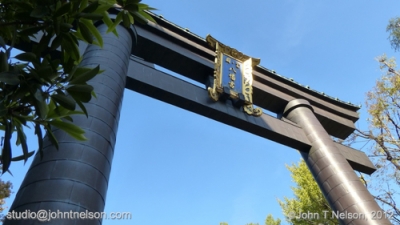John and Andrew pay a visit to the Tomioka-Hachimangu shrine and Fukagawa Fudouson temple in Monzen Nakacho. Monzen Nakacho, where we are staying, is the site of the Fukagawa Hachiman Matsuri, one of Tokyo’s “big three” festivals. This festival is HUGE and fills the streets of Monzen Nakacho, but it’s only held every three years and 2012 is not one of those years.
11:30am JST
Its a gorgeous, warm, sunny day in Tokyo. I’m hanging outside of the apartment building, soaking up rays while waiting for Andrew. I also have a nice chat with Claudia, another Sakura House resident, who is working on her thesis in the old court music of Japan. Claudia is new to Monzen Nakacho although she has stayed in Japan in the past with a host family in Tsukishima.
12:30pm JST
First up is the Fukagawa Fudouson temple. We walk to the East side of the Eitai Dori and pass through a large red tori gate, the entrance to the temple grounds. Just a block or two beyond this tori gate is the Fukugawa Fudouson main hall. Although Fukugawa Fudosoun is a Buddhist temple, it apparently shares the grounds with an Inari Shinto shrine. I still haven’t figured this one out yet.
Next up is the Tomioka Hachimangu shrine, home of the 4-ton Ichinomiya mikoshi, the largest mikoshi in the Kanto region. It is decorated with gold and precious stones and is housed behind glass in a climate controlled shelter. Because of its weight and value, this mikoshi is not carried into the Fukagawa Hachiman matsuri, but rather loaded on a trailer which itself is moved through town.
To one side of the walkway leading to the main shrine, we see monuments to ozeki and yokozuna sumo wrestlers from the past. One monument has the hand and foot imprints of these champions cast in stone. I compared my hands to theirs and my hands weigh in at perhaps 3/4 the size of these sumo from the past. On the other side of the main walkway leading to the shrine we find a statue of Ino Tadataka, who in the 19th century was the first person to map all of Japan. In his hand he carries what looks like a staff but is actually a compass on a gimble mount, one of his surveying tools used to create these maps.
Both the temple and shrine are celebrating the “753 Children’s Festival” wherein children of ages seven, five and three years old, come of age. They’re so cute, dressed up in their colorful formal kimonos.
Just before the sun sets, the mikoshi are illuminated, looking very impressive, like the crown jewels behind their glass cases, and then as the sun sets, metal protective doors are lowered to protect them for the night.
2:30pm JST
Time to get something to eat so we retire to 伊勢屋 (Iseya), a nearby restaurant where Andrew and I had dinner five years ago. This time I order soba with pork and vegetables, and a soft boiled egg on top. These soba bowls were yummy and enough to fill us up for the day. Last time we ate here we had root beer floats, desserts and ice cream being their specialty. Although there is nothing overly photogenic about the interior, I recommend Iseya.
After filling our bellies, we make a quick stop at Akafudado to see what’s good in the bakery section and then return to the apartments. The sun is setting early in Japan and I feel like getting some sleep before tomorrow’s adventures. I hear a rumor that Akihabara and Jimbocho might be on the plate for tomorrow!
7:00pm JST
Settled in for the evening with chocolate pastries and drinks and watching Gatchaman on Tokyo MX… yes, the original Gatchaman in Japanese! I’m a happy puppy!
